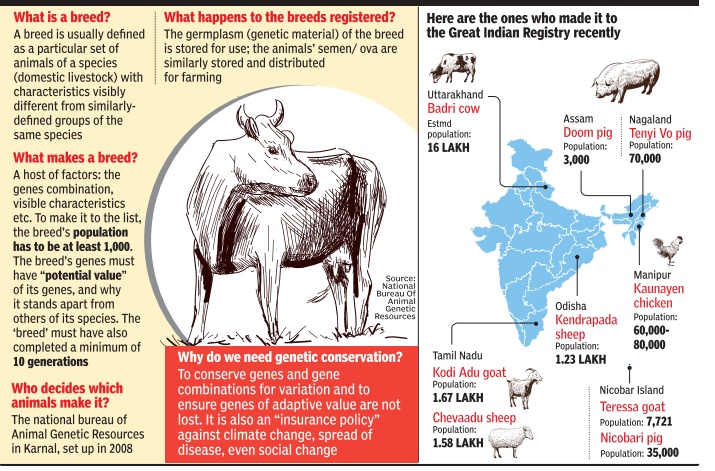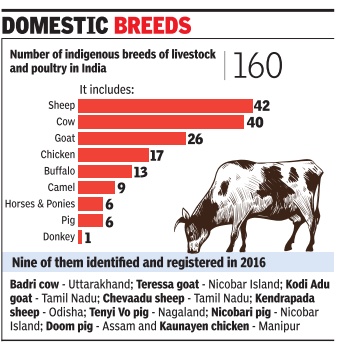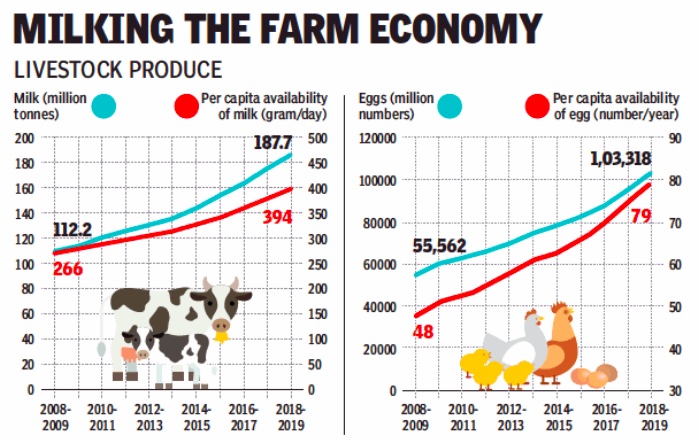Livestock and poultry: India

This is a collection of articles archived for the excellence of their content. |
Contents |
Breeds
2016: Nine new breeds
The Times of India, Aug 24 2016

Vishwa Mohan
Nine new breeds added to `desi' livestock family
The government has identified and registered nine new indigenous breeds of livestock and poultry in 2016, taking the list of `desi' breeds in the country to 160, including 40 of cows and 13 of buffaloes. The newly registered breeds were found to be more diseaseresistant than other known indigenous breeds.
“Registration of various unique populations as breeds shall help in inventorisation, improvement, conservation and sustainable utilisation of animal genetic resources of the country ,“ T Mohapatra, director general of Indian Council of Agricultural Research (ICAR), said on Tuesday after giving away certificates to applicants who registered the nine newly found indigenous breeds. These nine indigenous breeds of livestock and poultry include one breed of cow, two breeds each of goat and sheep, three breeds of pig and one breed of chicken. These breeds have been registered by Karnal-based National Bureau of Animal Genetic Resource.
Court verdicts
HC: Artificial insemination denies mating rights, is cruelty
Sureshkumar k, Sep 3 2021: The Times of India
Artificial insemination of native breeds of cattle denies mating rights of those animals, and also amounts to cruelty under the Prevention of Cruelty to Animals Act, 1960, Madras HC said, urging authorities to avoid the process.
“Artificial insemination deprives of bulls and cows the pleasure of mating which they are entitled to naturally. Reproduction by natural process is a basic biological need which cannot be interfered with,” said a division bench of Justice N Kirubakaran (since retired) and Justice P Velmurugan.
Denying and depriving right to copulate amounts to cruelty to animals under the provisions of the Prevention of Cruelty to Animals Act, the court added. The bench also ruled that only native-breed bulls should be permitted to run in jallikattu and other bull racing sport in Tamil Nadu and hybrid bulls should be prohibited from such events. State officials should certify the nativity of animals prior to the jallikattu event, bench said, and directed the state government to encourage bull owners to groom native breeds by providing subsidies.
Population
2012> 19
Vishwa Mohan , Oct 17, 2019: The Times of India

From: Vishwa Mohan , Oct 17, 2019: The Times of India
The livestock population in India has increased by 4.6%, from 512 million in 2012 to nearly 536 million in 2019. Though the overall number of cattle has increased only marginally, the cows, which account for over one-fourth of the total livestock population, showed an impressive increase of 18% over the previous census.
Even among the indigenous (desi) breeds of cattle, female ones (cows) showed a rise of 10% in their number. Overall population (male and female) of indigenous breeds of cattle, however, recorded a decline of 6% whereas population of cross-bred/exotic cattle recorded an increase of 27% over the 2012 census.
The 20th livestock census figures, released on Wednesday, show that 75% of total cattle are female (cows) — a clear sign of dairy farmers’ preferences for milk-producing cattle. This also gained momentum in the past few years due to the Centre’s aid in terms of providing sex-sorted artificial insemination, with semen of high-yielding bulls, free of cost at farmers’ doorstep. UP has recorded highest livestock population in 2019 followed by Rajasthan, MP, Bengal, Bihar, Andhra Pradesh, Maharashtra, Telangana, Karnataka and Gujarat.
Livestock products
2008-19

From: February 1, 2020: The Times of India
See graphic:
Production of milk and eggs, 2008-19
Details

From: Oct 22, 2019: The Times of India
See graphic:
Livestock and cow population in major states, 2012> 19: animal-wise and according to the top states
2015, 2016
Vishwa Mohan, Livestock products likely to meet target, Feb 17 2017: The Times of India

Decline In Production Of Wool
A day after coming out with an estimate of bumper foodgrain output, the agriculture ministry released on Thursday production figures of major livestock products, including milk and meat, for the JulyOctober period of last year which indicate that it is on track to meet the overall yearly target of 2016-17.
It claimed that the total production of milk, egg and meat had increased during July-October last year as compared to the corresponding period of 2015. Production of wool, however, decreased in 2016 as compared to the previous year.
The ministry comes out with such figures based on an integrated sample survey , conducted by states and Union territories during three seasons (summer, rainy and winter) every year.The estimate on Thursday was meant for the July-Octo ber (rainy) season.
“So far, we have come out with results of summer (March-June) and rainy (July-October) seasons. Final performance of 2016-17 would be known only after the winter seasons' (November-February) integrated survey ,“ said an official.
He said the results of the first two seasons were quite encouraging, showing that the country may even cross its target of 2016-17 in terms of milk, egg and meat production.
According to the estimate, India's milk production has touched 105.42 million tonnes (MT) so far (in eight months) as against the targeted production of 163.74 million tonnes in 2016-17.
“The total milk production has increased from 52.21 million tonnes during 2015-16 (rainy) to 54.50 million tonnes during 2016-17 (rainy), registering agrowth of 4.38%,“ said the agriculture ministry in its esti mate released on Thursday .
It even claimed that average milk yield per day has marginally improved for indigenous category of cows and buffaloes in 2016 as compared to 2015.
Total production of egg and meat has also shown similar results. The ministry said that the production of egg during the period was largely contributed by commercial poultry farms (75.75%) while remaining production was from household or backyard poultry .
However, there has been a decline in production of wool. The total wool production has decreased from 5.91 million kg during 2015-16 (rainy) to 5.78 million kg during 201617 (rainy) -a decline of 2.16%.As against the targeted production of 44.07 million kg during 2016-17, the total estimated production in two seasons (summer and rainy) is 20.66 million kg.
2017-18: milk increased 4.7%; eggs 7.4%
Milk, egg output up by 5% & 7%, January 17, 2018: The Times of India
The government released the country’s milk and egg production outlook for the year 2017-18, saying the total milk production has increased from 51.33 million tonnes during the summer season of 2016-17 to 53.77 million tonnes during the summer of 2017-18 registering a growth of 4.7%.
It also claimed that the total egg production has increased during the period - from 26.03 billion during 2016-17 (summer) to 27.95 billion during 2017-18 (summer), registering a growth of 7.4%.
“The first five highest milk producing states during the summer season of 2017-18 were Uttar Pradesh, Rajasthan, Gujarat, Madhya Pradesh, and Andhra Pradesh,” said the agriculture ministry in a statement.
The ministry comes out with the production outlook for both the summer and winter seasons. The final production figure for the current year (2017-18) will be known later once the winter figures are released. The total milk output in 2016-17 was 163.7 million tonnes.
The ministry noted that the production of egg is largely contributed by commercial poultry farms (nearly 80.83%) with remaining production coming from household/backyard poultry.
The first five highest eggs producing states during summer Season 2017-18 were Tamil Nadu, Andhra Pradesh, Telangana, West Bengal and Haryana.
Vis-à-vis the world: 2018

From: March 5, 2020: The Times of India
See graphic:
Production of cattle, chickens, goats, pigs and sheep in India, Australia, Bangladesh, Brazil, China, Indonesia, Pakistan and the USA, presumably as in 2018 or 19.
2022-23

From: June 23, 2024: The Times of India
See graphic:
Share of top 5 states for output of Livestock: 2022-23